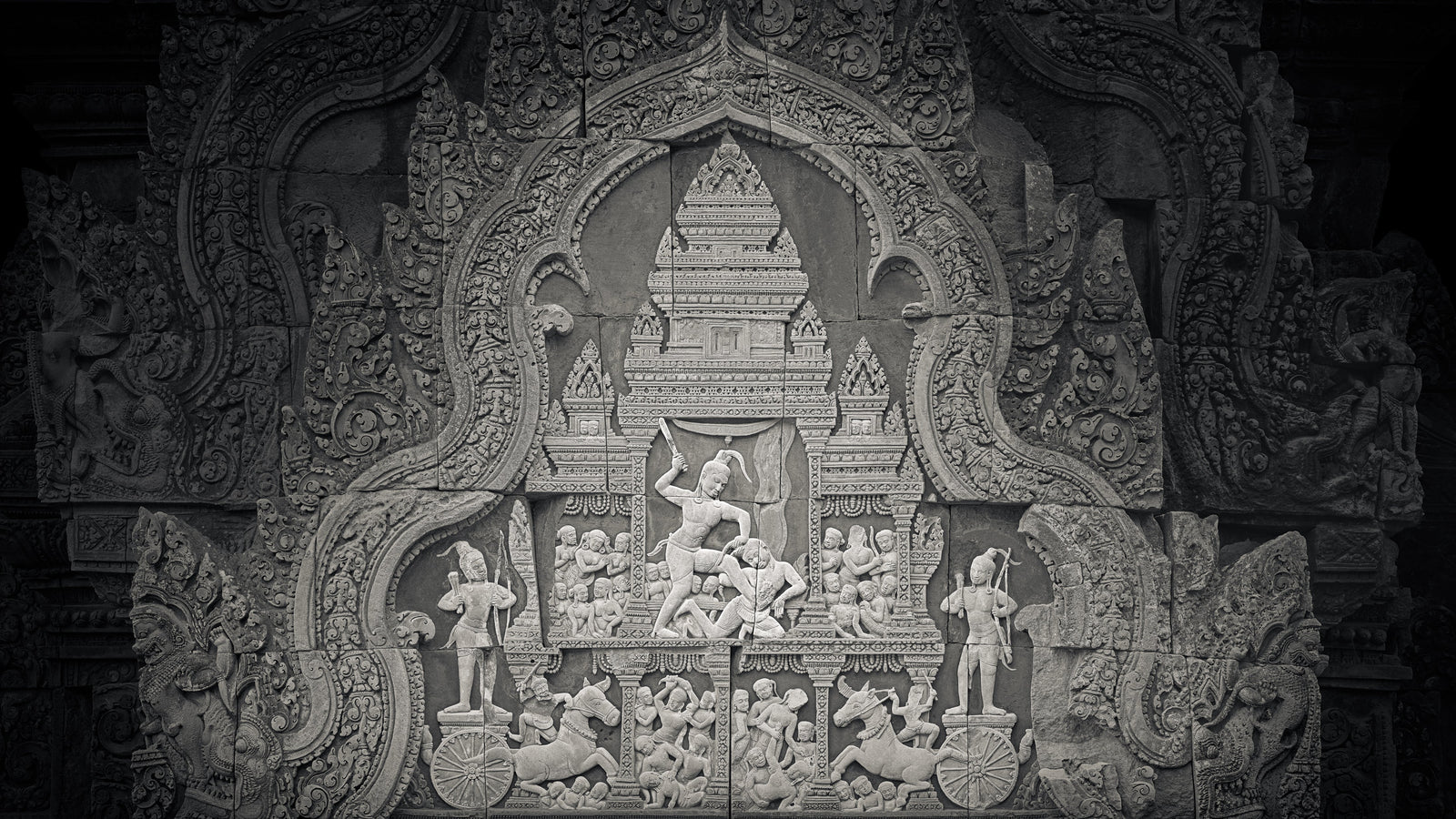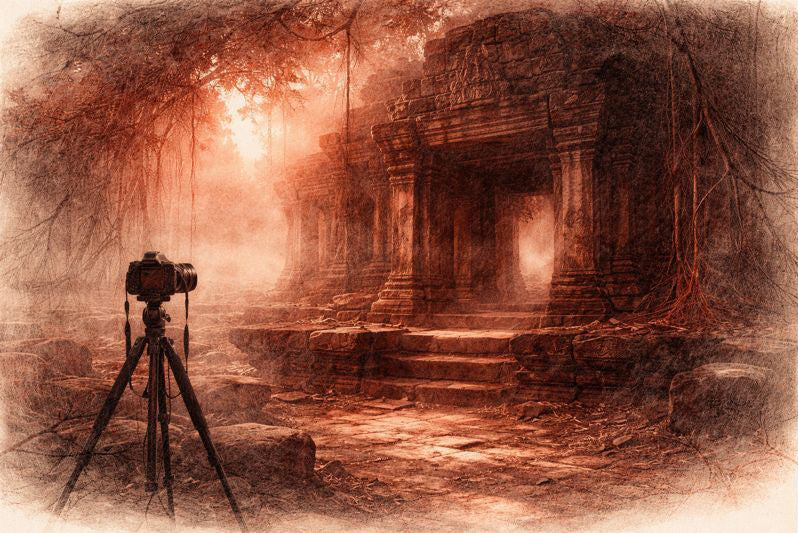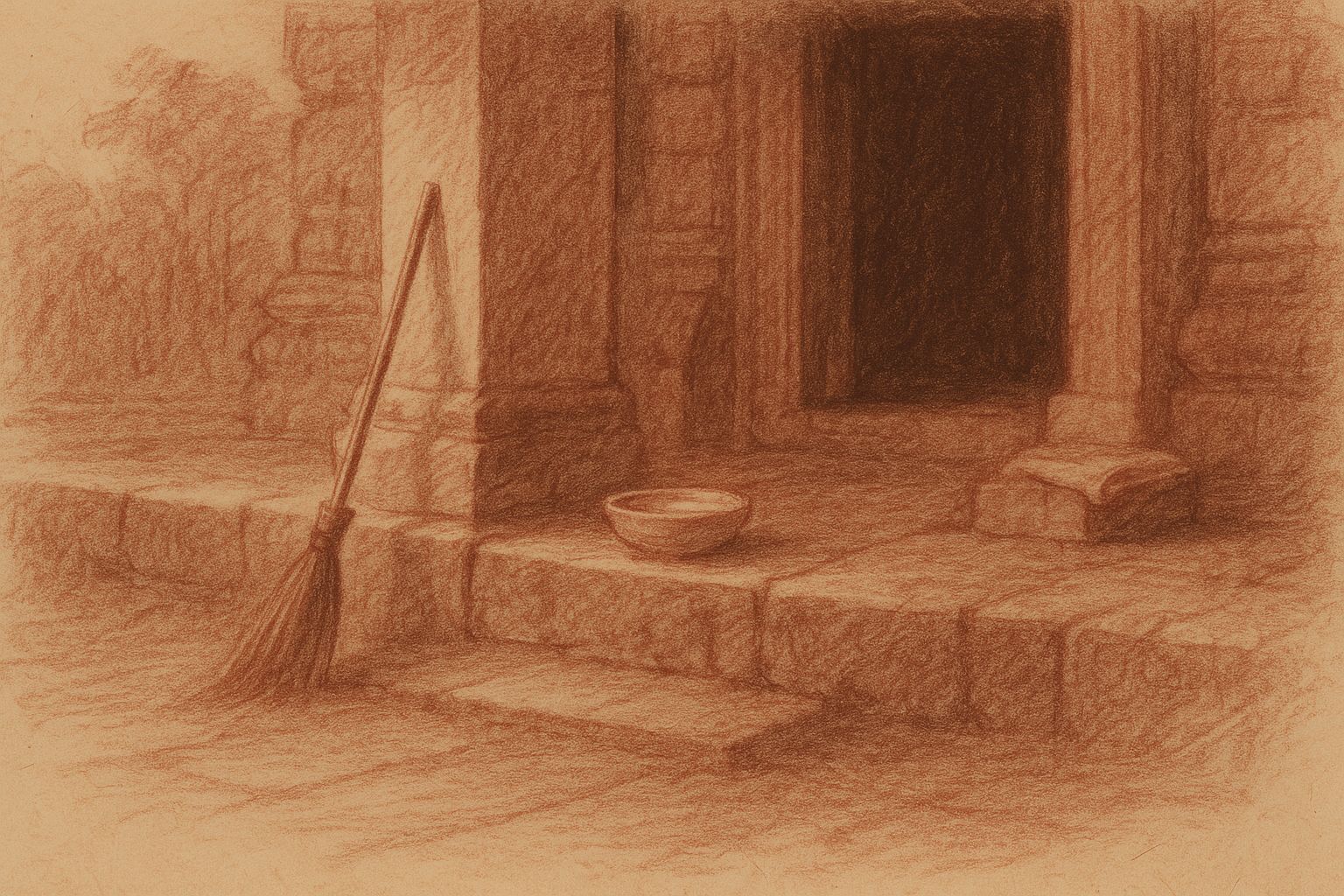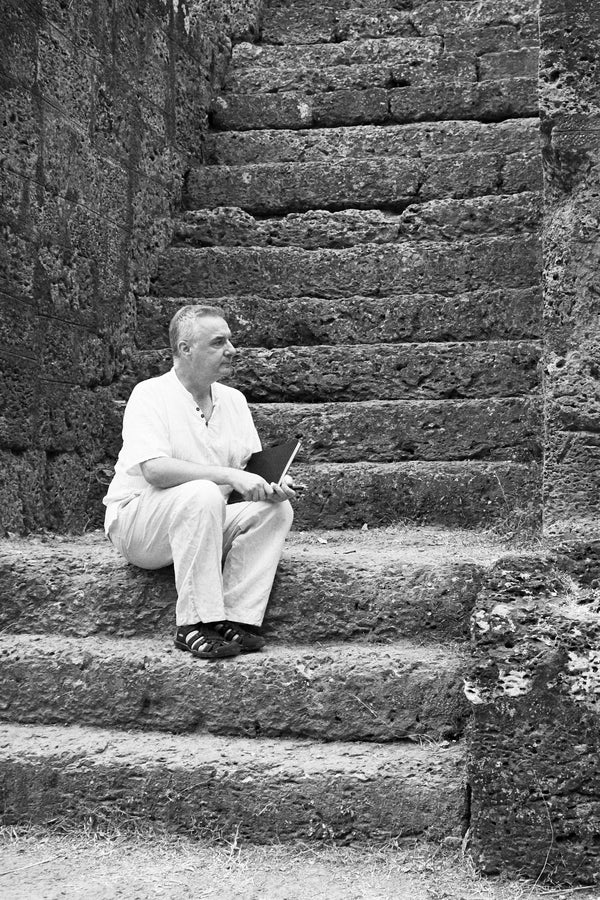Complimentary worldwide shipping on orders over $400 · No import tariffs for most countries
Complimentary worldwide shipping on orders over $400 · No import tariffs for most countries

About Krishna Slaying the Demon Kamsa, Banteay Srei Temple, Angkor, Cambodia. 2019
Exquisitely carved in the mid-10th century, the pediments of Banteay Srei Temple’s libraries were the first in Angkor to depict mythological scenes. These sandstone reliefs are amongst the finest in all Khmer art.
The tympanum depicted in Krishna Slaying the Demon Kamsa, Banteay Srei Temple, Angkor, Cambodia. 2019, carved into the west-facing pediment of the northern library, depicts Lord Krishna slaying the demon Kamsa, pulling him from his throne by the hair before striking him dead.
The scene takes place in Kamsa’s beautifully carved palace in Mathura. This depiction gives us an idea of how marvellous the wood-built palaces of Angkor must have been before being lost to time.
I imagine that the killing took place in Kamsa’s harem, judging by the large number of female witnesses. One can see clearly the agitation on the ladies’ faces as they watch on in horror, some holding their heads in despair, tugging on their hair, or falling fainted to the ground.
In the lower corners of the scene, we see Krishna and his brother Balarama arriving at the palace on horse-drawn chariots, holding bows and arrows.
Surrounding and behind the tympanum, receding into darkness, we can see the undulating triple layers of the pediment. To the sides of each layer there are makaras (legendary sea creatures in Hindu mythology, the guardians of gateways and thresholds) with tusks and trunks, disgorging Narasimha (fierce man-lion avatars of the Hindu god Vishnu, destroyer of evil and ender of religious persecution).
The Making of Krishna Slaying the Demon Kamsa, Banteay Srei Temple, Angkor, Cambodia. 2019
This image was extraordinarily difficult to make and took me almost eight hundred hours to complete. The central area of Banteay Srei’s second enclosure, where this library resides, is closed to the public to protect it from the ever increasing number of visitors, and this face-on view of the pediment is only available from some 17 metres (20 yards) away. One can approach to within a couple of metres (6’) on the northern side, but from this angle it is difficult to fully appreciate the exquisite richness and execution of the carving.
I made my initial studies of this scene by using binoculars as I sketched. Once I had envisioned the final image, I used a camera with a long telephoto lens to take almost five hundred photographs, each a study of a particular detail, and then stitched these details together to form the canvas on which I would “paint the light” to realise my vision. To paraphrase the great Ansel Adams, the photographs gave me the notes and chords, combined they formed the score, this final image is my performance.
As I worked on this piece, I found myself communing with the artists who crafted this masterpiece over one thousand years ago – perhaps the long, exacting labour was driving me insane, or perhaps these conversations were helping to preserve my sanity, I’m still not sure which. I would marvel at their mastery and dedication, at the countless hours it must have taken to craft this one small part of such a wondrous place, as hour after hour, week after week, I painstakingly attempted to do justice to their legacy.
It is with great honour and pride that I present to you Krishna Slaying the Demon Kamsa, Banteay Srei Temple, Angkor, Cambodia. 2019.
You can enjoy more of my images from Banteay Srei Temple by clicking here: My Work at Banteay Srei Temple.
If you enjoyed this article, and you would like to continue to share in my adventures, please sign up for my newsletter below. Since I no longer post on social media, this is the best way to stay up-to-date with my work.
Also in Library

Before the Shutter Falls
3 min read
Before the shutter falls, fear sharpens and doubt measures the cost of waiting. In the quiet hours before dawn, the act of not-yet-beginning becomes a discipline of attention. This essay reflects on patience, restraint, and the quiet mercy that arrives when outcome loosens its hold.

Those Who Keep the Way Open — On the Quiet Guardians of Angkor’s Thresholds
3 min read
Quiet gestures shape the way into Angkor — a swept stone, a refilled bowl, a hand steadying a guardian lion. This essay reflects on the unseen custodians whose daily care keeps the thresholds open, revealing how sacredness endures not through stone alone, but through those who tend its meaning.

Multiplicity and Mercy — The Face Towers of Jayavarman VII
5 min read
A new vision of kingship rises at the Bayon: serene faces turned to every horizon, shaping a world where authority is expressed as care. Moving through the terraces, one enters a field of steady, compassionate presence — a landscape where stone, light, and time teach through quiet attention.
Join My Studio Journal
Receive occasional letters from my studio in Siem Reap—offering a glimpse into my creative process, early access to new fine art prints, field notes from the temples of Angkor, exhibition announcements, and reflections on beauty, impermanence, and the spirit of place.
No noise. No clutter. Just quiet inspiration, delivered gently.
Subscribe and stay connected to the unfolding story.

Join My Studio Journal
Receive occasional letters from my studio in Siem Reap—offering a glimpse into my creative process, early access to new fine art prints, field notes from the temples of Angkor, exhibition announcements, and reflections on beauty, impermanence, and the spirit of place.
No noise. No clutter. Just quiet inspiration, delivered gently.
Subscribe and stay connected to the unfolding story.
